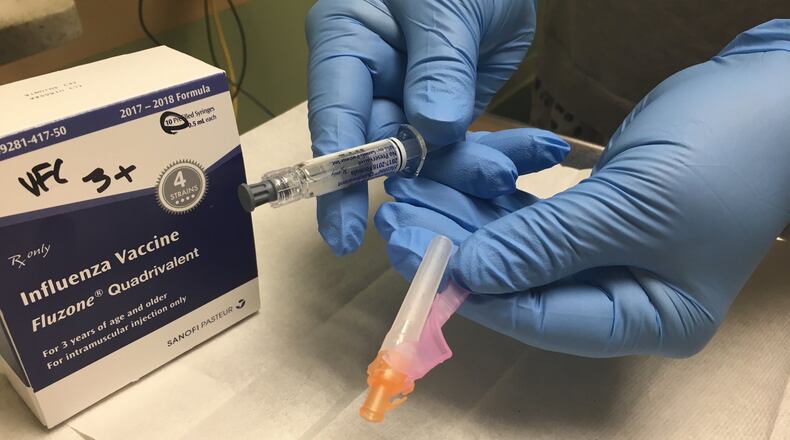RELATED: With flu cases on the rise, local hospitals to restrict visitors
Jonah — described by his parents as a brave warrior — died Saturday after he was admitted to Dayton Children’s Hospital, according to the Montgomery County Coroner’s Office. Ohio health officials also announced Wednesday a second child, a 1-year-old from Lucas County, died from the flu.
“No parent should ever have to suffer the loss of a child to the flu. Our hearts go out the family,” said Jon Woltmann, infectious disease department at Dayton Children’s Hospital. “We encourage parents to get their children vaccinated to not only protect them, but children who are not able to get the vaccine due to underlying health conditions.”
Statewide, flu-related hospitalizations have climbed to 3,854 confirmed flu-associated hospitalizations as of Jan. 6. There have been 713 flu cases at Dayton Children’s as of Jan. 6. There were 80 cases at Children’s the same time last year, when flu season came later and didn’t peak until toward the end of February.
RELATED: What is the H3N2 flu and how bad is flu season this year?
Jonah was born in Bulgaria and adopted by Richard and Valerie Rieben and 16 brothers and sisters in February 2017.
The Riebens said Jonah was “happiest when he was in the middle of the chaos and craziness of his large and loving family and would protest loudly if ever he was left out of the fun.”
“A brave warrior who fought and overcame many difficult battles throughout his short life, Jonah inspired us all with his strength and resiliency.”
Last year there were seven pediatric flu related deaths in Ohio.
Dr. Michael Dohn, medical director at Public Health - Dayton & Montgomery County, said “it’s a major annual epidemic that we at Public Health take very seriously.”
Public Health and the Centers for Disease Control and Prevention recommend that everyone 6 months or older get the flu shot as soon as possible.
The CDC says children are among high risk populations for the flu, along with populations like adults older than 50 years old, anyone with a compromised immune system, pregnant women, people with obesity, people in nursing homes and caregivers of people at high risk.
RELATED: Ohio flu hospitalizations exceed 2,000 this season
Children should get drink plenty of fluids and get rest if they do catch the flu. The severity of the flu can differ, and children who get the flu despite getting vaccinated typically have less severe illness than those that are unvaccinated.
Parents of children at high risk of flu complications should call their doctor right away if they have flu symptoms. Parents should also consult their doctor if their child has serious symptoms like having trouble breathing, not drinking enough fluids, acting lethargic or acting overly irritable.
The flu can be treated with prescription antiviral drugs, which need to be administered within the first two days of symptoms to be most effective.
Dr. Michael Dohn, medical director at Public Health - Dayton & Montgomery County, said parents can often sense when there’s something wrong with their child and need checked out by a doctor.
“We shouldn’t discount the fact that parents know their children and oftentimes know when something’s wrong,” he said.
Children starting back at school this time of year after Christmas break, and Woltmann said along with getting a vaccine, the best way to protect kids from getting sick is to reinforce good hygiene practices like hand washing and sneezing into the corner of your elbow.
“If your child is sick, do what you can to keep them home so they’re not getting other children sick as well,” he said.
Because kids are heavily exposed to the virus in school settings, children under the age 14 are not allowed to visit patients at local adult acute-care hospitals until March when flu cases slow down.
Getting the flu vaccine also helps create “herd immunity” and helps protect those without the vaccine, like kids under six months old.
“We know that if we prevent other people from getting sick, they can’t pass it on to other people that can’t get the vaccine themselves,” Woltmann said.
MORE: Local counties see ‘dramatic rise’ in flu hospitalizations
At the same time as flu season, Dayton Children’s is also having an uptick in patients with respiratory syncytial virus, or RSV, which has symptoms similar to the common cold.
He said infants that are under six months tend to have the most severe cases with symptoms like difficulty breathing, which is also when they need to be brought in to see a doctor.
“The children we’re most worried about are those that are infants up until about the first two years,” he said.
By the numbers: Dayton Children’s Hospital
713: Flu cases at Dayton Children’s October through first week in January 2018
80: Flu cases October through first week of January 2017
871: RSV cases October through first week of January 2018
735: RSV cases October through first week of January 2017
